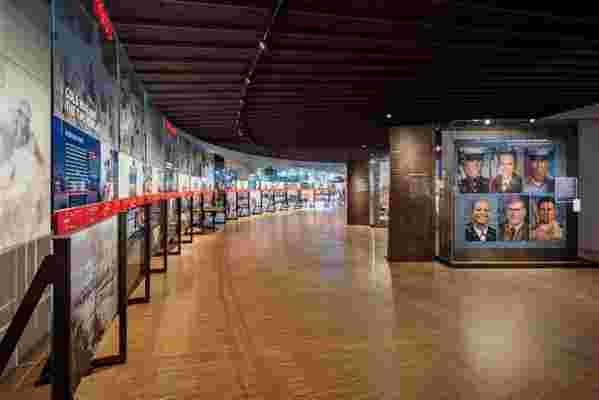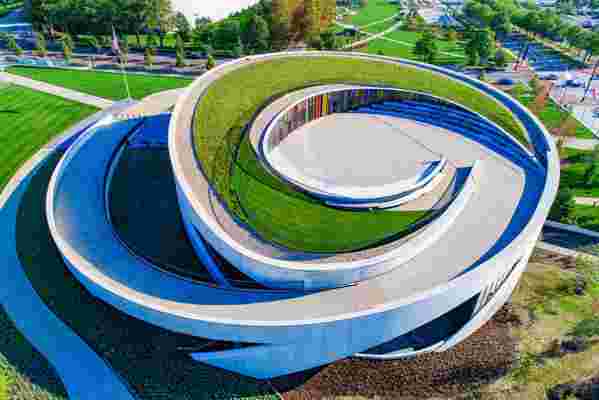There likely is not an American adult who hasn’t walked past, sat next to, or spoken with a veteran of the U.S. military. At one point they were our high school classmates, searching for the disciplined achiever within themselves while the rest us busied ourselves for traditional four-year universities. Later, they went off to wars in Europe, South East Asia, and the Middle East. When they returned, some faded into obscurity or drank to blunt whatever burdens they carried. Others joined community organizations, became teachers, doctors, or politicians. In short, their stories are as wide-ranging, complex, and diverse as their backgrounds. And for the first time in our country’s history, a museum will not just honor the men and women who served in all branches of the U.S. military but also tell their stories. When the National Veterans Memorial and Museum (NVMM) opens its doors to the public on October 27 in Columbus, Ohio, it’s not just that history will be made. Rather, it will be the culmination of meticulous planning and patriotic ambition toward a poetic quest to preserve the memory of the millions who have served, and those who are next in line.
The initial idea for the NVMM first came from Leslie H. Wexner, the founder, chairman, and CEO of L Brands, Inc. (and also the richest and most philanthropic man in Ohio). It began, ironically, from Wexner’s dislike (and that of nearly everyone in central Ohio, including this writer, who grew up in Columbus) for the original Franklin County Veterans Memorial in Columbus. “The original veterans memorial building, quite frankly, was hideous,” says Wexner. “The only thing relating to veterans in that original memorial, really, was its name. My wife and I started thinking, and eventually we decided to engage John Glenn to build a new county veterans memorial.” Like anything Wexner had put his mind to in the past, this project began gaining momentum and turning heads in the process. One man who took notice was the governor of Ohio, asking Wexner if he’d be willing to alter this county memorial into one that spanned statewide. But it didn’t stop there. More influential people jumped on board, eventually leading Wexner and his team to the halls of the U.S. Congress to ask for a national museum and memorial designation. From there, it was a linear path for Columbus to host its first-ever national museum.

Stairs leading up to the National Veterans Memorial and Museum, a stunningly beautiful structure that took nearly three years to complete.
All that was left, of course, was building the structure. Which, to be sure, was no small feat. After an invitation-only competition, Wexner and his team selected the U.S. firm Allied Works Architecture to design the exterior of the building. For the landscaping, the firm OLIN was tasked with creating a green aesthetic that was both inviting and inspiring. For the interiors, which would narrate the soldiers experience to visitors, Wexner turned to arguably the best museum designer in the country, Ralph Appelbaum Associates (the firm is responsible for such heavy hitters as the National Museum of African American History and Culture , the U.S. Holocaust Memorial Museum, and the National World War I Museum, to name a few).
When modern buildings become too self-conscious they almost instantly date themselves. With this museum, though, whether you quickly glance at it, or really take the time to study its presence, you’ll come to understand its timelessness.
The museum will house 30,000 square feet of exhibition space, nearly all of which will be used to explain the veterans’ experiences. “Rather early on in the process, we decided this museum wasn’t going to be about guns or tanks or the machines of war,” says Wexner, “but rather about the American veteran. In our research we found that the American veteran’s story is singular throughout the country’s history—from the Revolutionary War through today’s wars in Iraq and Afghanistan—soldiers have been expressing the same emotions in their letters. It’s all so dramatic, heartbreaking, and, at times, beautiful.”

Looking down one of the halls, the building will house artifacts, multimedia exhibits, and installations to remind visitors of all that the nation’s veterans have sacrificed.
As the lead patron, Mr. Wexner had an enormous influence on the building’s design. Typically, the 81-year-old businessman prefers classical architecture (anyone who’s visited the luxe northeast Columbus suburb of New Albany—a locale that quickly swelled in unison with the growth of Wexner’s clothing empire—will see his love for neoclassical motifs in every single office space and home, almost all of which are uniform in aesthetic). Yet, the design for the NVMM is anything but classical. Far from it, in fact. “When modern buildings become too self-conscious they almost instantly date themselves,” says Mr. Wexner. “With this museum though, whether you quickly glance at it, or really take the time to study its presence, you’ll come to understand its timelessness.”

An aerial view shows the rooftop sanctuary, a place where visitors can sit and reflect while enjoying views of the surrounding cityscape.
Creating that sense of timelessness was no easy task, especially when the architects at Allied Works Architecture were attempting to ensure the structure looked like no other of its kind. “The building is a poetic act. Its role is to make a place that’s like no other. As a result, there was no direct inspiration in the design,” says Brad Cloepfil, principal at Allied Works Architecture. “The genesis of the design was really about creating a sacred domain for veterans. If you break it down, the building is one big processional up the ramp that lifts each visitor from the earth and toward the sky.”
The museum is a space to remember but it’s a place to celebrate that sense of giving oneself to a greater good.
The crux of the building is the rooftop sanctuary, a place where visitors can sit and reflect. It will also allow for uninhibited views of the nearby Scioto River and downtown Columbus skyline. “Once we created that volume in the sky with the rooftop sanctuary, I wanted there to be a monumental structure supporting. Part of the idea of representing U.S. veterans is by making something beautiful for them to be proud of and look at in awe, and be eager to show to their families and loved ones,” says Cloepfil. “It’s a place of memory.”
An aerial image shows the views of the river and nearby downtown skyscrapers. The entire property that houses the NVMM features some 251 trees from 21 different varieties.
The museum has a dignified form that appears to be organically grown from the ground. Yet there was nothing organic about its layout. The ribbons that weave their way upward not only look beautiful, providing a unifying aesthetic, but they have an egalitarian purpose as well. “John Glenn explained that a lot of the veterans coming to appreciate the space will be of an older generation and might be sitting in wheelchairs,” says Wexner. “So we wanted to ensure that we could seamlessly build ramps into the facade to help them get around. We wanted them to feel comfortable getting in and around the space without taking anything away from the opportunity of building something stunning for Columbus.”
Once inside the NVMM, visitors will move through a structure that houses artifacts, multimedia exhibits, and installations explaining the veteran’s story. It’s an experience that Cloepfil believes has lost significance in modern American society. “Senator Glenn had an abiding sense that Americans were losing the ethics of service, the idea of serving of giving of yourself to your country,” says Cloepfil. “Not being of a military family myself, there’s an ethical reason behind the project, and that’s what really struck me and made me so excited to be a part of something that represented the service to a greater cause. Because it’s currently waning in our culture.”
Experiencing the museum’s rooftop will be among the many memories visitors will take with them when leaving the NVMM.
Beautiful architecture aside—which this structure certainly displays—the NVMM was erected for one reason: a pledge that those who served and sacrificed so much for this country are never forgotten. Because, as some would argue, the alternative is a bleak future, for if the sum of our lives amounts to a forgotten memory, then nothing lasts and ultimately, nothing matters. In these terms, life has no pattern and the elasticity of sacrifice is meaningless. But if we allow ourselves to learn from those who came before us—be it through literature, or art, or museums—then we can see our lives reflected in previous ones, and a sense of harmony is possible. Indeed, when we know that we’re members of a larger narrative, that we too will be remembered by our actions, then our present and future find shape and purpose.
The museum is bringing in a star-studded lineup of board members, including Lieutenant General Michael Ferriter, a three-star general, as the president and CEO, and Colin Powell as the Honorary Chair of the Board of Advisors.
To be sure, Cloepfil felt this abiding sense of giving back to society when he created the space. “The museum is a space to remember but it’s a place to celebrate that sense of giving oneself to a greater good,” says Cloepfil. “Yes, it’s heart-wrenching and tragic at times, but it’s also incredibly inspiring as a reminder that we all need to give in our own way.” A familiar past will almost always create a better future, and Columbus’s National Veterans Memorial and Museum is a testament to that creed.
